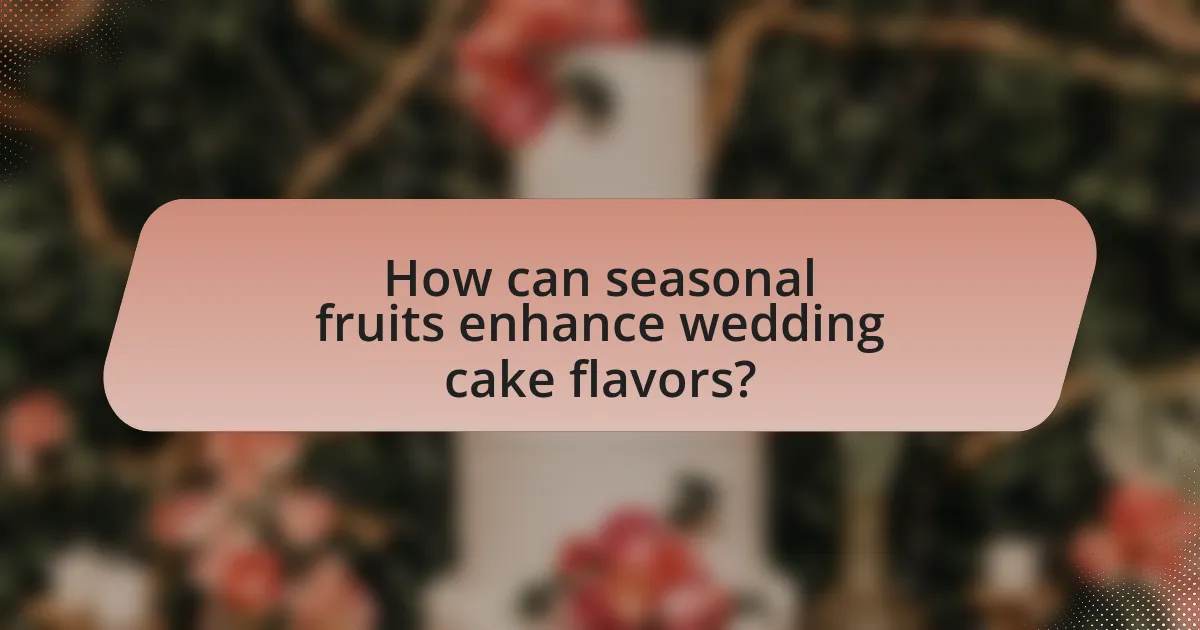The article focuses on how to incorporate seasonal fruits into wedding cake flavors, highlighting their ability to enhance taste, freshness, and visual appeal. It discusses the benefits of using fruits at their peak ripeness, which not only improves flavor but also supports local agriculture and sustainability. Key sections cover the impact of seasonal fruits on flavor profiles, aesthetic advantages, and specific fruits suitable for different seasons. Additionally, the article provides practical tips for incorporating fruits into cake recipes, fillings, and frostings, as well as creative decoration techniques to elevate the overall wedding cake experience.

How can seasonal fruits enhance wedding cake flavors?
Seasonal fruits enhance wedding cake flavors by providing fresh, vibrant tastes that complement the cake’s sweetness. The natural acidity and unique flavor profiles of seasonal fruits, such as strawberries in spring or peaches in summer, can balance the richness of cake layers and frostings. For example, using ripe strawberries can add a tartness that contrasts beautifully with a creamy vanilla frosting, while peaches can introduce a juicy sweetness that elevates a buttercream layer. Additionally, seasonal fruits are often at their peak ripeness during specific times of the year, ensuring maximum flavor and nutritional value, which can significantly improve the overall taste experience of the wedding cake.
What are the benefits of using seasonal fruits in wedding cakes?
Using seasonal fruits in wedding cakes enhances flavor, freshness, and visual appeal. Seasonal fruits are at their peak ripeness, which means they offer superior taste and texture compared to out-of-season alternatives. For instance, strawberries in June or peaches in August provide vibrant flavors that can elevate the overall cake experience. Additionally, incorporating seasonal fruits can reduce costs, as they are more readily available and often less expensive during their harvest periods. This practice also supports local agriculture, promoting sustainability by sourcing ingredients that are in season and locally grown.
How do seasonal fruits impact flavor profiles?
Seasonal fruits significantly enhance flavor profiles by providing freshness, natural sweetness, and unique taste characteristics that vary throughout the year. For instance, summer fruits like strawberries and peaches offer bright, juicy flavors, while winter fruits such as citrus and apples contribute tartness and warmth. The use of seasonal fruits in culinary applications, including wedding cakes, allows for the incorporation of flavors that are at their peak ripeness, resulting in a more vibrant and complex taste experience. Research indicates that fruits harvested in their natural season contain higher levels of sugars and acids, which directly influence their flavor intensity and overall quality.
What aesthetic advantages do seasonal fruits provide?
Seasonal fruits provide vibrant colors and diverse textures that enhance the visual appeal of wedding cakes. Their natural hues, such as the deep reds of strawberries or the bright yellows of mangoes, create striking contrasts against the cake’s frosting, making the dessert more enticing. Additionally, the unique shapes and sizes of seasonal fruits can add an artistic element to cake designs, allowing for creative arrangements that draw attention. For example, using fresh berries can create a rustic look, while tropical fruits can evoke a more exotic feel. These aesthetic advantages not only elevate the cake’s presentation but also contribute to a memorable dining experience for guests.
Which seasonal fruits are best for wedding cakes?
Seasonal fruits that are best for wedding cakes include strawberries, raspberries, peaches, and citrus fruits like lemons and oranges. These fruits are not only flavorful but also visually appealing, enhancing the overall aesthetic of the cake. Strawberries and raspberries are typically in season during late spring and summer, providing a fresh and vibrant taste. Peaches are also a summer fruit, known for their sweetness and juiciness, making them ideal for cake fillings or decorations. Citrus fruits, available in winter and early spring, add a zesty flavor that complements many cake types. Their seasonal availability ensures freshness, which is crucial for the quality of wedding cakes.
What fruits are in season during spring?
Strawberries, cherries, apricots, and rhubarb are fruits that are in season during spring. These fruits typically become available from March through June, depending on the region. For example, strawberries are often harvested in late spring, while cherries and apricots follow shortly after. Rhubarb, although technically a vegetable, is commonly used in desserts and is also in season during this time. This seasonal availability allows for fresh and flavorful ingredients to be incorporated into wedding cake flavors, enhancing the overall taste and experience.
Which fruits are popular in summer wedding cakes?
Popular fruits in summer wedding cakes include strawberries, blueberries, peaches, and raspberries. These fruits are favored for their vibrant colors and refreshing flavors, which complement the light and airy nature of summer desserts. Strawberries and blueberries, for instance, are often used in layered cakes and as decorative toppings due to their seasonal availability and appeal. Peaches add a juicy sweetness that pairs well with creamy frostings, while raspberries provide a tart contrast that enhances the overall flavor profile.
What autumn fruits can be incorporated into wedding cakes?
Autumn fruits that can be incorporated into wedding cakes include apples, pears, figs, and cranberries. These fruits not only enhance the flavor profile of the cakes but also align with the seasonal theme of autumn. For instance, apples can be used in spiced apple cake recipes, while pears add moisture and sweetness. Figs provide a rich, unique taste, and cranberries contribute a tart contrast, making them ideal for fillings or toppings. The use of these fruits is supported by their availability during the autumn months, ensuring freshness and optimal flavor in wedding cakes.
How can winter fruits be utilized in wedding cake designs?
Winter fruits can be utilized in wedding cake designs by incorporating them as decorative elements, flavor components, and natural accents. For instance, fruits like pomegranates, citrus, and pears can be arranged on top of the cake or used as a garnish, enhancing visual appeal and adding seasonal relevance. Additionally, these fruits can be pureed or used in fillings and frostings, providing unique flavors that complement traditional cake recipes. The use of winter fruits not only adds aesthetic value but also aligns with seasonal themes, making the cake more memorable for the occasion.

How do you incorporate seasonal fruits into cake recipes?
To incorporate seasonal fruits into cake recipes, use fresh fruits as key ingredients in the batter, filling, or as a topping. For example, during summer, berries can be folded into the batter for added flavor and moisture, while in fall, apples can be grated and mixed into the cake for a spiced apple cake. Additionally, seasonal fruits can be pureed and added to frostings or glazes, enhancing both taste and visual appeal. This method not only utilizes the peak flavor of the fruits but also aligns with seasonal availability, ensuring freshness and quality in the final product.
What are the best methods for adding fruits to cake batter?
The best methods for adding fruits to cake batter include folding in fresh or dried fruits, pureeing fruits for a smoother texture, and using fruit juices or zests for flavor enhancement. Folding in fresh fruits, such as berries or diced apples, helps maintain their structure and adds bursts of flavor, while dried fruits like raisins or cranberries can provide concentrated sweetness. Pureeing fruits, such as bananas or peaches, integrates moisture and flavor evenly throughout the batter. Additionally, incorporating fruit juices or zests, like orange or lemon, can enhance the overall taste profile without altering the batter’s consistency. These methods ensure that the fruits complement the cake’s texture and flavor, resulting in a well-balanced dessert.
How can purees be used effectively in cake recipes?
Purees can be used effectively in cake recipes by replacing a portion of the fat or liquid, enhancing flavor and moisture. For instance, fruit purees like apple, banana, or berry can add natural sweetness and a rich texture while reducing the need for added sugars and fats. Research indicates that using purees can improve the overall sensory qualities of baked goods, making them more appealing to consumers. Additionally, purees can contribute to a more vibrant color and a unique taste profile, aligning well with seasonal fruit themes in wedding cakes.
What are the advantages of using whole fruits versus fruit extracts?
Whole fruits offer several advantages over fruit extracts, primarily due to their complete nutritional profile and natural composition. Whole fruits contain fiber, vitamins, minerals, and phytonutrients that are often lost during the extraction process. For instance, the fiber in whole fruits aids digestion and helps regulate blood sugar levels, while antioxidants present in the skin and pulp contribute to overall health. Additionally, whole fruits provide a more authentic flavor and texture, enhancing the sensory experience in culinary applications, such as wedding cakes. Studies have shown that the presence of whole fruit can improve the overall taste and moisture content of baked goods, making them more appealing to consumers.
How can seasonal fruits be used in cake fillings and frostings?
Seasonal fruits can be used in cake fillings and frostings by incorporating them as purees, chunks, or in compotes to enhance flavor and texture. For example, strawberries can be pureed and mixed with cream cheese for a filling, while peaches can be cooked down into a compote and folded into buttercream for a frosting. This method not only adds natural sweetness but also provides moisture and vibrant color to the cake. The use of seasonal fruits aligns with culinary practices that emphasize freshness and flavor, making cakes more appealing and relevant to the time of year.
What types of fillings work best with seasonal fruits?
Cream cheese, mascarpone, and fruit curds are the best types of fillings to pair with seasonal fruits. Cream cheese filling offers a tangy contrast that complements the sweetness of fruits like strawberries and peaches. Mascarpone provides a rich, creamy texture that enhances the flavor of berries and citrus fruits. Fruit curds, such as lemon or passion fruit, add a vibrant acidity that balances the natural sweetness of seasonal fruits, making them ideal for cakes featuring flavors like raspberry or mango. These fillings not only enhance the overall taste but also create a harmonious blend of flavors that elevate wedding cake experiences.
How can fruits be incorporated into buttercream or cream cheese frostings?
Fruits can be incorporated into buttercream or cream cheese frostings by pureeing the fruit and mixing it into the frosting base. This method allows for even distribution of flavor and color throughout the frosting. For example, using fresh strawberries or raspberries, which contain about 90% water, can create a vibrant and flavorful frosting when pureed and combined with the butter or cream cheese. Additionally, using fruit extracts or zests can enhance the fruit flavor without adding excess moisture, which is crucial for maintaining the frosting’s consistency.

What are some creative ways to showcase seasonal fruits in wedding cakes?
Seasonal fruits can be creatively showcased in wedding cakes by incorporating them into the cake layers, using them as decorative elements, and creating fruit-based fillings or toppings. For instance, fresh berries can be layered between cake tiers, while citrus slices can be candied and placed on top for an elegant finish. Additionally, fruit purees can be used to flavor buttercreams or fillings, enhancing both taste and visual appeal. This approach not only highlights the freshness of seasonal produce but also aligns with the trend of using locally sourced ingredients, which is increasingly popular in wedding catering.
How can seasonal fruits be used for decoration?
Seasonal fruits can be used for decoration by incorporating them into cake designs, centerpieces, and table settings. For example, fresh berries, citrus slices, or stone fruits can be arranged artistically on wedding cakes to enhance visual appeal and complement flavors. Additionally, fruits can be used in garlands or as accents around the cake, creating a vibrant and natural aesthetic. The use of seasonal fruits not only adds color and texture but also aligns with the theme of freshness and seasonal celebration, making them a popular choice in wedding decor.
What are some popular fruit garnishing techniques?
Popular fruit garnishing techniques include slicing, carving, and arranging fruits artistically on desserts. Slicing fruits like strawberries or kiwis enhances their visual appeal and makes them easy to eat. Carving techniques, such as creating flowers from melons or intricate designs from citrus peels, add a decorative touch that elevates presentation. Arranging fruits in a colorful pattern or layering them can create a stunning visual effect, making the dessert more enticing. These techniques are widely used in culinary presentations to enhance the aesthetic and flavor profile of dishes, particularly in events like weddings where visual appeal is crucial.
How can fruits be arranged for visual impact on wedding cakes?
Fruits can be arranged on wedding cakes for visual impact by using a combination of color, texture, and placement. Strategically layering fruits in clusters or cascading them down the sides of the cake creates a dynamic visual effect. For instance, vibrant berries can be grouped together to contrast with the cake’s frosting, while larger fruits like figs or citrus slices can be placed at focal points to draw attention. Additionally, incorporating greenery, such as mint or edible leaves, enhances the overall aesthetic by adding depth and freshness. This method not only beautifies the cake but also emphasizes the seasonal aspect of the fruits used, aligning with the theme of incorporating seasonal flavors into wedding cakes.
What are some unique flavor combinations with seasonal fruits?
Unique flavor combinations with seasonal fruits include peach and basil, which offers a sweet and herbaceous profile; strawberry and balsamic vinegar, enhancing the fruit’s sweetness with acidity; and lemon and blueberry, providing a bright and tangy contrast. Additionally, pairing watermelon with feta cheese creates a refreshing and savory balance, while figs and goat cheese deliver a rich and creamy texture. These combinations are popular in culinary applications, showcasing how seasonal fruits can elevate flavors in desserts, particularly in wedding cakes.
How can spices and herbs complement seasonal fruits in cakes?
Spices and herbs can enhance the flavor profile of seasonal fruits in cakes by adding depth and complexity. For instance, cinnamon and nutmeg can amplify the sweetness of fruits like apples and pears, while basil or mint can introduce a refreshing contrast to berries. Research indicates that the combination of spices and fruits can create a more balanced taste experience, as seen in traditional recipes where spices are used to highlight the natural flavors of seasonal produce. This synergy not only elevates the overall flavor but also contributes to a more aromatic and appealing cake.
What are some unexpected pairings that work well with seasonal fruits?
Unexpected pairings that work well with seasonal fruits include herbs like basil and mint, spices such as cardamom and cinnamon, and savory elements like cheese or prosciutto. For instance, strawberries paired with basil create a refreshing contrast, while peaches combined with prosciutto offer a sweet and salty balance. Additionally, cardamom enhances the flavor of apples, and cinnamon complements pears beautifully. These combinations not only elevate the taste profile but also add complexity to desserts, making them ideal for wedding cake flavors that incorporate seasonal fruits.
What tips should you consider when using seasonal fruits in wedding cakes?
When using seasonal fruits in wedding cakes, prioritize freshness and flavor compatibility. Fresh seasonal fruits enhance the cake’s taste and visual appeal, making them a popular choice for wedding cakes. For example, strawberries in spring or peaches in summer can add vibrant colors and natural sweetness. Additionally, consider the moisture content of the fruits; fruits with high water content, like watermelon, may require adjustments in the cake’s recipe to prevent sogginess. Pairing fruits with complementary flavors, such as citrus with vanilla or berries with chocolate, can elevate the overall taste profile. Lastly, ensure that the fruits are properly prepared, washed, and sliced to maintain hygiene and presentation.
